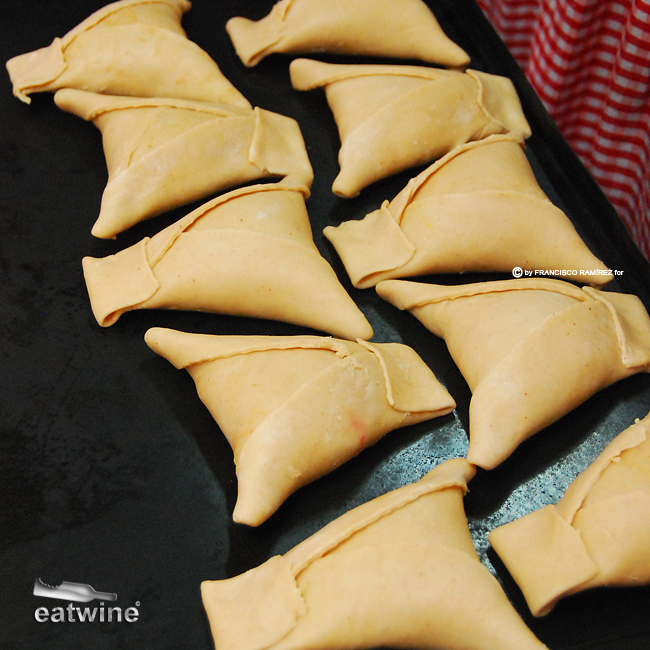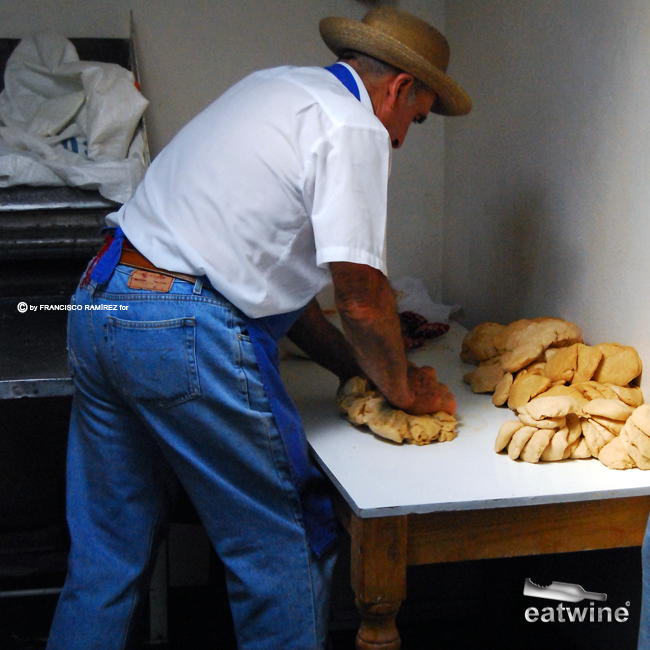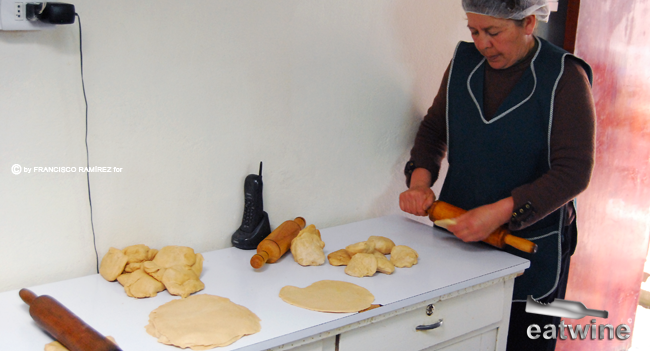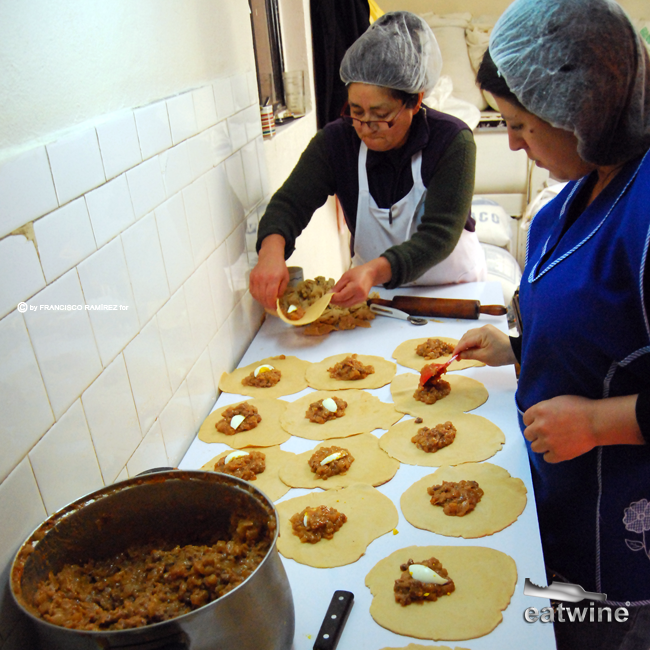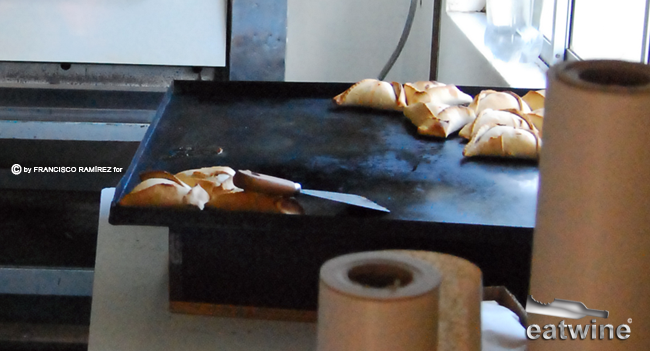Over the Dieciocho, Chilean Independence, holiday, we traveled to Talca to see my husband’s parents in the countryside. Since it had been quite a while since my last visit, I petitioned a carga, order, of Señora María’s empanadas from the nearby village of San Clemente. Señora María is somewhat of an empanada celebrity in these parts and during “18”, when empanadas are consumed by the dozens, she has a wait list to get the goods. That’s right—a wait list. The daily quota she makes is 1,000 empanadas. When it’s filled, lo siento.
Knowing this, my father-in-law called in his order weeks before for a dozen. My husband and I went to fetch them on the holiday. There are no signs, or even a house number for that matter. We quickly gathered from the chaotic parking situation (an otherwise quiet, dead-end street) with a combo of dirty trucks and Mercedes, that we had found the right address. Just as on our previous visit, the aroma of empanadas wafted through the yard and to the corner. Señora María has converted her patio/garage into two rooms where they simultaneously pump out these stuffed dough turnovers, made in the timeless Chilean way.
Using flour from the Cunaco mill in Colchagua, real pork lard, and a saline water solution, a cook kneads with serious elbow grease. Pulling off a tennis ball-sized piece, this señora (a team of 5 women and one man to do the lifting) rolled out the dough quickly into a perfect circle.
Next station. Assembling the pino, the savory beef filling. Secret number two. Use good quality sirloin with a little fat. Cook your onions till sweet and translucent. Good empanadas in Chile are measured by how caldúa, soupy/juicy, they are. When they are perfect, upon biting, the juice should dribble down your arm to your elbow. How to achieve this? Make the filling ahead of time and chill it. The juice (and fat) will congeal and make it spoon-able to fill the empanada.
On the little dough round goes a quarter cup of the filling, a slice of hard-boiled egg and a whole black olive. Another woman tidily folds over the dough into a triangular shape, sealing the edges with the care as if she was diapering a newborn baby. Listo. Now to the oven for 20 minutes until golden brown (next room).
In the next room, a duo of gas-fired ovens are pumping out these little treats. I pay and am given a simple, warm box. Beneath are the empanadas. I lift the brown paper and take a big whiff. Ahhh. Perhaps what I most love about empanadas is their aroma. A deep meaty, yeasty, toasty, savory, homey fragrance. It makes me nostalgic for the Dieciocho, Señora María, my parents-in-law, the countryside, Chile.
Here’s the traditional recipe to try at home from our cookbook. To accompany these empanadas, open a bottle of hearty Chilean Cabernet Sauvignon or an earthy Carmenere. While empanadas can certainly replace pizza for dinner, Chileans actually adore them (with red wine) for Sunday brunch. Leftovers? I think so.
Empanadas de Pino
2 pounds all-purpose flour (roughly 8 cups)
3⁄4 cup pork lard
2 cups warm water mixed with 1⁄2 teaspoon salt
3 tablespoons vegetable oil
2 pounds sirloin, cut into small cubes
1 teaspoon ground cumin
2 teaspoons mild chili sauce
4 large onions, chopped
2 tablespoons paprika
1⁄2 teaspoon fresh black pepper
4 hard-boiled eggs, cut into quarters
16 black olives
1⁄3 cup golden raisins
1 egg, beaten
Place flour in a mixing bowl. Melt lard and pour into the flour. Pull together with wooden spoon then add the salted water. Knead until soft and uniform. Let the dough rest for 30 minutes covered with a kitchen towel before rolling out.
Heat 1 tablespoon oil and fry sirloin cubes until seared on all sides, about 5 minutes. Mix with cumin and chili sauce. Remove and reserve. Wipe the pan clean. Add rest of oil to hot pan and fry onions until translucent, about 15 minutes. They should not caramelize nor brown, if so, turn down the heat. One tip when cutting the onions is to chop them small yet in thick squares. This will help them retain their juice, necessary for the soupy consistency.
When onions are ready, incorporate salt, paprika, and black pepper. Fold in meat mixture. Chill thoroughly. Ideally, do this step the night before to chill overnight and fully leverage the congealing process.
Now to make the empanadas. Roll tennis-ball sized portions of the dough into circles. One way to achieve this is to roll-out to 1/8-inch thickness, use a salad plate, and cut around it. Place 2-3 tablespoons of the filling, the hard-boiled egg quarter, 2 raisins, olive.
To fold and seal, wet the edges of the empanada lightly with water. To form the traditional trapezoidal shape, first fold the top down flat and pinch with your fingers, and then fold in each side. Be sure they are securely sealed to not let precious juice escape during the baking process.
“Paint” the empanadas with the egg wash and place on a greased tray. Bake in a pre-heated oven at 170C/375F for about 20 minutes. They should be light golden brown with a slightly crusty texture on the folds but feel otherwise tender.
One last tip. Let them rest about 5-10 minutes out of the oven. Your tongue will thank you for avoiding an unnecessary scalding.
Yield: 12-16 empanadas (varies depending on the exact size of your dough circles)

